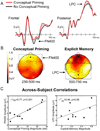Brain substrates of implicit and explicit memory: the importance of concurrently acquired neural signals of both memory types
- PMID: 18691605
- PMCID: PMC2621065
- DOI: 10.1016/j.neuropsychologia.2008.07.010
Brain substrates of implicit and explicit memory: the importance of concurrently acquired neural signals of both memory types
Abstract
A comprehensive understanding of human memory requires cognitive and neural descriptions of memory processes along with a conception of how memory processing drives behavioral responses and subjective experiences. One serious challenge to this endeavor is that an individual memory process is typically operative within a mix of other contemporaneous memory processes. This challenge is particularly disquieting in the context of implicit memory, which, unlike explicit memory, transpires without the subject necessarily being aware of memory retrieval. Neural correlates of implicit memory and neural correlates of explicit memory are often investigated in different experiments using very different memory tests and procedures. This strategy poses difficulties for elucidating the interactions between the two types of memory process that may result in explicit remembering, and for determining the extent to which certain neural processing events uniquely contribute to only one type of memory. We review recent studies that have succeeded in separately assessing neural correlates of both implicit memory and explicit memory within the same paradigm using event-related brain potentials (ERPs) and functional magnetic resonance imaging (fMRI), with an emphasis on studies from our laboratory. The strategies we describe provide a methodological framework for achieving valid assessments of memory processing, and the findings support an emerging conceptualization of the distinct neurocognitive events responsible for implicit and explicit memory.
Figures



Similar articles
-
Neural correlates of conceptual implicit memory and their contamination of putative neural correlates of explicit memory.Learn Mem. 2007 Apr 5;14(4):259-67. doi: 10.1101/lm.529807. Print 2007 Apr. Learn Mem. 2007. PMID: 17412965 Free PMC article. Clinical Trial.
-
Neural substrates of explicit and implicit fear memory.Neuroimage. 2009 Mar 1;45(1):208-14. doi: 10.1016/j.neuroimage.2008.11.015. Epub 2008 Nov 28. Neuroimage. 2009. PMID: 19100329 Free PMC article.
-
Event-related brain potentials in memory: correlates of episodic, semantic and implicit memory.Clin Neurophysiol. 2003 Jun;114(6):1144-52. doi: 10.1016/s1388-2457(03)00044-0. Clin Neurophysiol. 2003. PMID: 12804683
-
The porous boundaries between explicit and implicit memory: behavioral and neural evidence.Ann N Y Acad Sci. 2011 Apr;1224:174-190. doi: 10.1111/j.1749-6632.2010.05946.x. Ann N Y Acad Sci. 2011. PMID: 21486300 Review.
-
The neural basis of implicit learning and memory: a review of neuropsychological and neuroimaging research.Neuropsychologia. 2013 Aug;51(10):2026-42. doi: 10.1016/j.neuropsychologia.2013.06.019. Epub 2013 Jun 24. Neuropsychologia. 2013. PMID: 23806840 Review.
Cited by
-
Functional differences between statistical learning with and without explicit training.Learn Mem. 2015 Oct 15;22(11):544-56. doi: 10.1101/lm.037986.114. Print 2015 Nov. Learn Mem. 2015. PMID: 26472644 Free PMC article.
-
Using stimulus form change to understand memorial familiarity for pictures and words in patients with mild cognitive impairment and Alzheimer's disease.Neuropsychologia. 2010 Jun;48(7):2068-74. doi: 10.1016/j.neuropsychologia.2010.03.027. Epub 2010 Apr 1. Neuropsychologia. 2010. PMID: 20362596 Free PMC article.
-
Who can you trust? Behavioral and neural differences between perceptual and memory-based influences.Front Hum Neurosci. 2009 Aug 20;3:16. doi: 10.3389/neuro.09.016.2009. eCollection 2009. Front Hum Neurosci. 2009. PMID: 19738922 Free PMC article.
-
Real-time neural signals of perceptual priming with unfamiliar geometric shapes.J Neurosci. 2010 Jul 7;30(27):9181-8. doi: 10.1523/JNEUROSCI.0403-10.2010. J Neurosci. 2010. PMID: 20610752 Free PMC article. Clinical Trial.
-
Manipulating letter fluency for words alters electrophysiological correlates of recognition memory.Neuroimage. 2013 Dec;83:849-61. doi: 10.1016/j.neuroimage.2013.07.039. Epub 2013 Jul 19. Neuroimage. 2013. PMID: 23871869 Free PMC article.
References
-
- Bentin S, Moscovitch M, Heth I. Memory with and without awareness: Performance and electrophysiological evidence of savings. Journal of Experimental Psychology: Learning, Memory, and Cognition. 1992;18:1270–1283. - PubMed
-
- Buckner RL, Goodman J, Burock M, Rotte M, Koutstaal W, Schacter D, et al. Functional-anatomic correlates of object priming in humans revealed by rapid presentation event-related fMRI. Neuron. 1998;20:285–296. - PubMed
-
- Buckner RL, Wheeler ME. The cognitive neuroscience of remembering. Nature Reviews Neuroscience. 2001;2:624–634. - PubMed
-
- Curran T, Tepe KL, Piatt C. ERP explorations of dual processes in recognition memory. In: Zimmer HD, Mecklinger A, Lindenberger U, editors. Handbook of binding and memory: Perspectives from cognitive neuroscience. Oxford: Oxford University Press; 2006. pp. 467–492.
Publication types
MeSH terms
Grants and funding
LinkOut - more resources
Full Text Sources
Other Literature Sources
Medical

